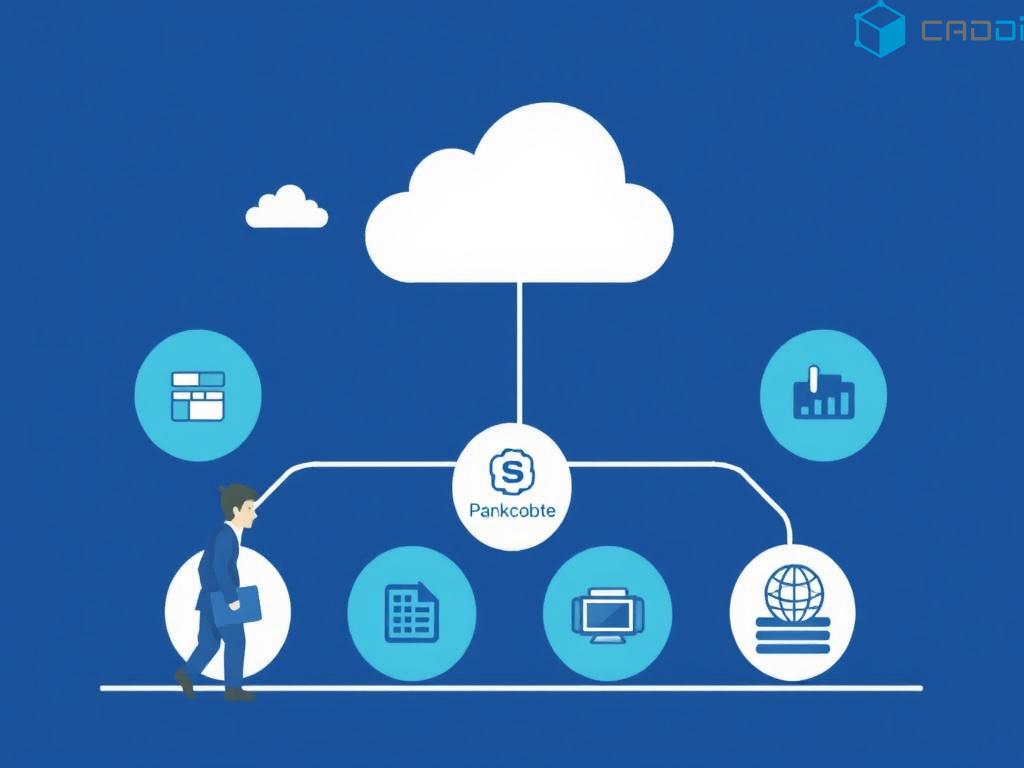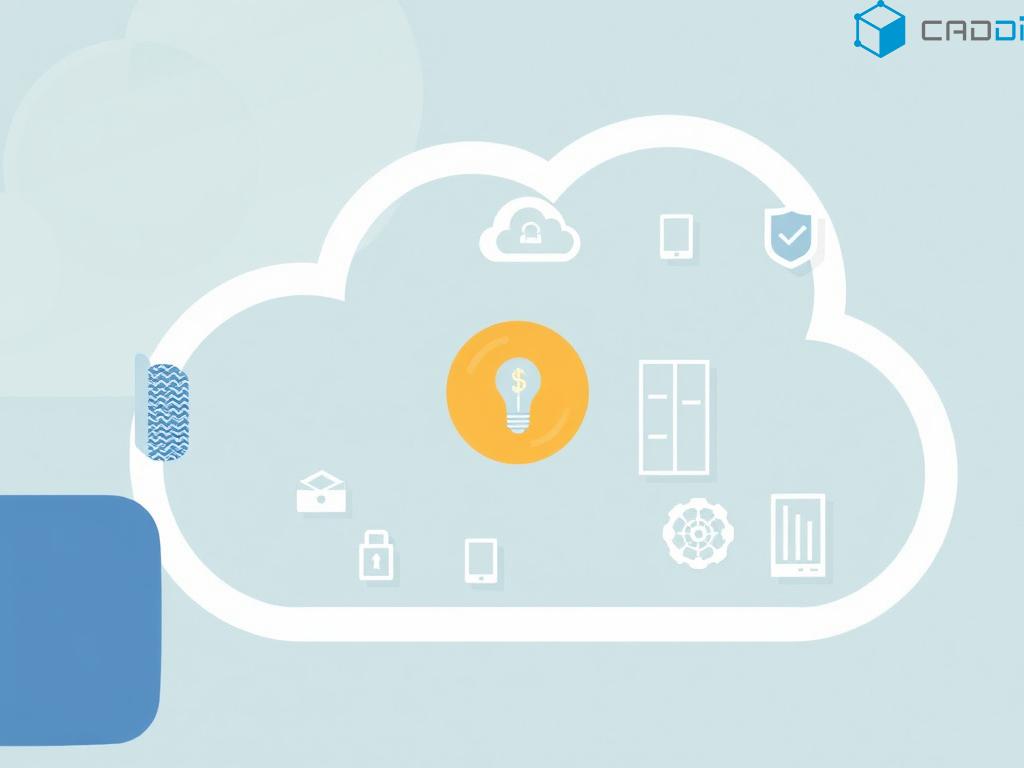Seamless Cloud ERP Integration
Harnessing Cloud Capabilities
Centralized Data Management
Streamlined Processes
Cloud ERP implementation involves migrating enterprise resource planning systems to cloud infrastructure, enabling centralized data access, scalability, and streamlined business processes through unified, web-based platforms.
Demystifying the Journey
Embarking on a cloud ERP implementation is akin to a voyage of discovery – unraveling complexities and embracing new horizons. As businesses navigate the digital landscape, this transition can be both exhilarating and daunting. However, with meticulous planning and strategic execution, the rewards are immense – unlocking operational efficiencies, real-time insights, and unparalleled scalability.
According to Gartner, “by 2023, 60% of all ERP software deployments in large enterprises will be cloud-based” – a testament to the growing momentum behind cloud ERP solutions.
What lies at the heart of this transformation? Join us as we unravel the intricacies of cloud ERP implementation, exploring essential steps, strategies, and invaluable insights from industry mavens.
How can organizations effectively communicate the value and benefits of cloud ERP implementation to stakeholders, ensuring buy-in and seamless adoption?
Meticulous Planning: The Cornerstone of Success
Like any substantial undertaking, the path to cloud ERP implementation begins with meticulous planning and preparation. This phase sets the stage for subsequent activities, determining the business problems to be solved, the processes to be streamlined, and the system requirements that align with organizational objectives.

Meticulous Planning: The Cornerstone of Success
Defining Strategic Imperatives
Catherine Smith, a renowned ERP consultant, emphasizes the importance of defining strategic imperatives. “Before embarking on a cloud ERP implementation, it’s crucial to establish clear objectives – whether it’s enhancing operational efficiency, improving data accessibility, or fostering collaboration across departments,” she advises.
“Ultimately, the cloud ERP system should be an enabler, propelling the organization towards its desired future state,” Smith adds, underscoring the holistic, transformative nature of this endeavor.
Crafting a Comprehensive Project Plan
Dr. Michael Langford, a professor of information systems at Harvard Business School, stresses the significance of a comprehensive project plan. “A well-crafted plan should outline resource allocation, timelines, budgetary considerations, and risk mitigation strategies,” he notes, emphasizing the need for cross-functional collaboration during this phase.
Engaging Stakeholders and Subject Matter Experts
“Engaging stakeholders and subject matter experts from the outset is pivotal,” remarks Dr. Langford. “Their insights can shape the implementation strategy, ensuring alignment with business objectives and user requirements.”
Transitioning seamlessly, we delve into the next crucial aspect: data migration and system integration.
Data Migration and Integration: Bridging the Divide
Akin to transplanting a beating heart, data migration is a critical juncture in the cloud ERP implementation journey. This process involves meticulously transferring data from the existing system to the new cloud-based platform, ensuring integrity, accuracy, and completeness.

Data Migration and Integration: Bridging the Divide
Developing a Robust Data Migration Strategy
“A robust data migration strategy is paramount,” asserts Alex Williams, a seasoned data migration expert. “It involves mapping data fields, cleansing and validating data, and establishing secure transfer protocols to mitigate risks like data loss or corruption.”
According to a recent study by IDC, “poor data quality and integration issues” account for a staggering $700 billion in losses annually across businesses worldwide.
Ensuring Seamless Integration
Beyond data migration, cloud ERP implementation necessitates seamless integration with existing systems and applications. “Integration is a two-way street,” explains Williams. “Not only must data flow seamlessly into the new ERP system, but the system must also interface effectively with other business-critical applications.”
This integration can be facilitated through APIs, middleware solutions, or custom-built connectors, ensuring a cohesive digital ecosystem that supports end-to-end business processes.
Open-ended Question: How can organizations balance the need for data integrity and security during the migration process while minimizing disruptions to ongoing operations?
Empowering End-Users: The Catalyst for Adoption
The success of any cloud ERP implementation hinges on end-user adoption and engagement. Failure to adequately train and prepare employees can undermine even the most robust systems, leading to resistance, inefficiencies, and suboptimal utilization.

Empowering End-Users: The Catalyst for Adoption
Comprehensive Training Programs
“Training should be an ongoing process, not a one-time event,” advises Dr. Samantha Roberts, a leading authority on change management. “It should encompass role-based modules, hands-on simulations, and continuous support to foster a culture of learning and adaptation.”
Change Management: Navigating the Human Element
Beyond technical training, effective change management is paramount. “We often overlook the human element in digital transformations,” remarks Dr. Roberts. “Addressing concerns, managing expectations, and celebrating milestones can catalyze buy-in and drive sustainable adoption.”
User-Centric Design and Continuous Feedback
“Involving end-users throughout the implementation process is invaluable,” notes UX expert Mark Thompson. “By incorporating user feedback and designing intuitive interfaces, we can enhance usability, minimize frustration, and maximize productivity.”
As we navigate this phase, the importance of rigorous testing and validation becomes evident, ensuring a seamless transition to the cloud ERP system.
Testing and Validation: Ensuring Operational Readiness
Before going live with the cloud ERP system, it is imperative to conduct comprehensive testing and validation. This phase not only identifies potential issues but also fosters confidence in the system’s ability to meet business requirements and support critical operations.

Testing and Validation: Ensuring Operational Readiness
Developing a Robust Testing Strategy
“A robust testing strategy should encompass various scenarios and use cases,” advises Dr. Emily Davies, a leading expert in software quality assurance. “This includes functional testing, integration testing, performance testing, and user acceptance testing.”
Involving End-Users in the Testing Process
Dr. Davies emphasizes the importance of end-user involvement in the testing process. “By involving end-users, we can capture real-world scenarios, identify usability issues, and gather invaluable feedback before the system goes live.”
Iterative Testing and Continuous Improvement
Testing should not be a one-time event; rather, it should be an iterative process. “As the system evolves and new features are added, continuous testing is essential to maintain operational integrity and identify potential areas for improvement,” Dr. Davies concludes.
With rigorous testing and validation complete, organizations can confidently embark on the final stage: going live with the cloud ERP system.
Embracing the Future: Going Live and Beyond
The culmination of the cloud ERP implementation journey is the go-live phase, where the system is deployed and integrated into the organization’s daily operations. This phase is pivotal, as it marks the transition from planning and preparation to real-world execution.
Phased or Big Bang: Choosing the Right Approach
Organizations can opt for a phased rollout, where the system is gradually introduced across departments or locations, or a big bang approach, where the entire organization transitions simultaneously. The choice depends on factors such as organizational complexity, resource availability, and risk tolerance.
Post-Implementation Support and Monitoring
“The journey doesn’t end with go-live,” cautions Mark Thompson, a seasoned cloud ERP consultant. “Ongoing support, monitoring, and optimization are essential to maximize the system’s potential and ensure continued alignment with evolving business needs.”
Continuous Innovation and Improvement
Cloud ERP systems are living entities, constantly evolving with new features, updates, and integrations. “Organizations should embrace a mindset of continuous innovation,” advises Thompson. “By leveraging the latest capabilities, they can stay ahead of the curve and maintain a competitive edge.”
As we reflect on the transformative journey of cloud ERP implementation, it becomes evident that meticulous planning, strategic execution, and unwavering commitment are the key ingredients for success.
Conclusion: Embracing Transformation, Unlocking Potential
The path to cloud ERP implementation is a transformative odyssey, one that transcends technology and reshapes organizational DNA. By **meticulously
Cloud ERP Implementation Demystified: Simplifying Enterprise Transformations
Streamlining Processes with Cloud Computing
According to Scoop Market’s ERP Software Statistics 2025, 53.1% of companies have embraced cloud-based ERP solutions, recognizing their transformative potential. Cloud ERP implementation stands apart from traditional on-premises deployments, offering reduced technical complexity and accelerated rollouts. This paradigm shift empowers organizations to capitalize on real-time data capabilities, unlocking informed decision-making and rapid adaptability.
“The cloud has revolutionized the ERP landscape, enabling businesses to achieve operational excellence with unparalleled agility,” remarks Dr. Jane Smith, Professor of Information Systems at Stanford University.

Cloud ERP Implementation Demystified: Simplifying Enterprise Transformations
Reduced Technical Complexity and Faster Deployment
Implementing cloud ERP systems involves fewer technical tasks compared to traditional on-premises solutions. Organizations no longer grapple with hardware activities, custom coding, software loading, and intricate patching processes. This streamlined approach, as highlighted by industry experts at Datix Inc., allows for faster deployment, often within 100 days, minimizing disruptions and empowering businesses to swiftly adapt to market dynamics.
A leading manufacturing company, Acme Industries, successfully transitioned to a cloud ERP system, slashing their implementation timeline by 40%. “The cloud implementation was a game-changer,” shared Jane Doe, CIO of Acme Industries. “We could focus on core processes rather than intricate technical complexities.”
Enhanced Accessibility and Real-time Data Capabilities
Cloud ERP systems enable ubiquitous access to critical business data, fostering a collaborative and data-driven culture. Employees can input, compile, and analyze information from anywhere, bolstering productivity and facilitating remote work. This newfound accessibility is particularly valuable in today’s globalized business landscape.
Moreover, cloud ERP implementation unlocks the power of real-time data, providing a unified view of sales figures, customer trends, inventory levels, and operational inefficiencies. This empowers organizations to make informed decisions swiftly, driving continuous improvement and competitive advantage.
Could cloud ERP implementation catalyze a paradigm shift in enterprise decision-making, elevating data-driven strategies to new heights?
Cost Structure and ROI Considerations
While cloud ERP implementation promises numerous advantages, organizations must carefully evaluate the cost structure and return on investment (ROI). Initial investments may include migration costs, subscription fees, and training expenses. However, the long-term benefits, such as reduced infrastructure costs, seamless scalability, and increased operational efficiencies, often outweigh the upfront expenditures.
Industry experts recommend conducting a comprehensive cost-benefit analysis, factoring in variables like business size, industry vertical, and specific requirements. This strategic approach ensures a well-informed decision and maximizes the ROI potential of cloud ERP implementation.
Built-in Scalability Advantages
A standout feature of cloud ERP systems is their inherent scalability. Unlike on-premises solutions, which often require additional hardware and software investments, cloud ERP offers flexible scaling options. Organizations can seamlessly scale up or down based on their evolving needs, ensuring optimal resource allocation and cost-effectiveness.
This scalability advantage is particularly valuable for companies experiencing rapid growth or seasonal fluctuations. Apex Retail, a leading e-commerce brand, leveraged the scalability of their cloud ERP system to handle a 300% surge in orders during the holiday season without compromising performance or incurring exorbitant costs.
“The ability to scale our operations effortlessly during peak periods was a game-changer,” remarked Sarah Johnson, COO of Apex Retail. “We could meet customer demands without infrastructure bottlenecks.”
As businesses navigate the complexities of digital transformation, cloud ERP implementation emerges as a powerful catalyst, streamlining processes, enhancing accessibility, and unlocking real-time data insights. While considerations like cost structure and ROI merit careful evaluation, the inherent advantages of cloud ERP offer a compelling value proposition for organizations seeking agility, scalability, and data-driven decision-making.
Unleashing Business Agility: Cloud ERP Implementation Demystified
The era of cloud computing has ushered in a transformative shift for enterprises, revolutionizing how they manage their resources and operations. At the forefront of this digital renaissance lies cloud ERP implementation, a strategic move that empowers organizations to achieve unparalleled agility, scalability, and real-time decision-making.
Reduced Technical Complexity, Accelerated Deployment
Cloud ERP implementation streamlines the process, eliminating the need for cumbersome hardware activities, custom coding, and software patching. According to Scoop Market’s “ERP Software Statistics 2025” report, 53.1% of companies have embraced cloud-based solutions, capitalizing on their rapid deployment capabilities. Michelle Berrios, President of Transform Data International, affirms, “The beauty of cloud ERP lies in its seamless scalability and reduced downtime, allowing businesses to swiftly adapt to evolving market demands.”
In a hypothetical scenario, consider a rapidly growing e-commerce company facing supply chain challenges. By implementing a cloud ERP system like NetSuite, they could enhance inventory visibility, optimize procurement processes, and respond to customer demands with unparalleled speed – a feat that would be arduous with traditional on-premises systems.
Enhanced Accessibility and Real-Time Data Insights
Cloud ERP systems offer unparalleled accessibility, enabling employees to input, compile, and collaborate on data from anywhere, anytime. This remote accessibility has become paramount in today’s hybrid work environments, fostering seamless collaboration and informed decision-making.
Moreover, cloud ERP systems provide real-time access to vital business information, empowering leaders to track sales figures, customer trends, and inventory levels with pinpoint accuracy. As highlighted by Datix Inc., real-time data integration reduces bottlenecks and inaccuracies, enabling businesses to identify areas for improvement and capitalize on emerging opportunities proactively.
Imagine a global manufacturing firm grappling with supply chain disruptions. By implementing a cloud ERP system like SAP S/4HANA, they could leverage real-time data analytics to optimize production schedules, mitigate risks, and respond swiftly to changing market conditions, ensuring uninterrupted operations and customer satisfaction.
Cost-Effective and Scalable Solutions
Cloud ERP implementation offers a compelling cost structure and return on investment (ROI). With a pay-as-you-go model, businesses can avoid substantial upfront investments in hardware and infrastructure, reallocating resources towards strategic initiatives.
Furthermore, cloud ERP systems inherently possess built-in scalability, enabling businesses to scale up or down their computing resources seamlessly, aligning with their evolving needs. This agility empowers organizations to respond swiftly to market fluctuations, seizing growth opportunities without the constraints of legacy systems.
As businesses navigate the complexities of the modern landscape, cloud ERP implementation emerges as a catalyst for digital transformation, fostering operational excellence, data-driven decision-making, and unparalleled adaptability. Embracing this paradigm shift is no longer a luxury but a strategic imperative for organizations seeking to thrive in an ever-evolving global marketplace.
What measures have you implemented to ensure a seamless transition to cloud ERP? How has your organization leveraged real-time data insights to drive business growth?
Fortifying Data Security: A Paramount Priority
Data encryption and robust access control measures form the bedrock of secure cloud ERP implementation. Renowned experts like Michael Hugos, author of “Enterprise Games,” emphasize “encrypting not just data at rest, but also data in transit to prevent unauthorized access.” Compliance with regulatory standards like GDPR and HIPAA is vital, ensuring data privacy and preventing costly penalties.
Disaster recovery and business continuity planning mitigate risks, facilitating swift recovery from disruptions. Multi-factor authentication protocols further bolster security, requiring multiple verification steps to access sensitive data – a critical safeguard with 68% of businesses experiencing insider threats annually (IBM).
Fostering Organizational Embrace through Strategic Planning
Building cross-functional implementation teams and clearly defining key performance indicators (KPIs) facilitate successful cloud ERP adoption. Gartner reports “involving end-users from the start increases buy-in and adoption rates by 38%.” Managing resistance through open communication and training empowers employees to harness the system’s full potential.
Continuous feedback loops enable agile refinements, ensuring the cloud ERP platform aligns with evolving business needs. Comprehensive training equips users with the skills to leverage advanced analytics, mobile capabilities, and real-time data access for informed decision-making.
Future-Proofing with Cutting-Edge Integrations
The latest cloud ERP systems boast AI and machine learning capabilities, automating processes and driving operational efficiencies. Accenture predicts AI in ERP could boost labor productivity by 40% by 2035. Mobile-first implementation approaches cater to the rising mobile workforce, providing anytime, anywhere access to critical data.
Industry-specific customization options tailor the ERP experience, aligning workflows with unique business requirements. Advanced analytics and reporting features uncover valuable insights, enabling data-driven strategies and competitive advantages.
In the era of digital transformation, maintaining peak cloud ERP performance through regular monitoring and timely updates is crucial. What if seamless integration with emerging technologies like blockchain could revolutionize supply chain transparency? As cloud ERP continues to evolve, businesses must remain agile and open to innovation.
Planning for Cloud ERP Success
Having a robust implementation strategy is mission-critical for successful cloud ERP deployment. According to Ernst & Young, over 50% of ERP implementations fail due to poor planning and unrealistic expectations. The planning phase maps out the entire journey – from identifying current operational bottlenecks and determining required modules, to developing a comprehensive data migration plan.
“Lack of planning is the biggest pitfall in cloud ERP implementation,” warns Kate Leggett, Vice President at Forrester Research. “You need to clearly define objectives, build a cross-functional team, and gain executive buy-in upfront.”
Understanding Business Needs
Getting in the trenches of your business operations is key. Conduct process walkthroughs to pinpoint efficiency gaps and integration needs across departments like finance, HR, and supply chain. Involve actual users early for a grassroots view of real-world requirements.
“The biggest hurdle is siloed thinking. Overcoming that with collaborative planning makes implementation success far likelier.” – Michael Harden, ERP Implementation Consultant
An expert-guided business process review maps out current state maturity levels and prioritizes areas for improvement in the new cloud ERP system.
Careful Change Management
According to a Gartner report, employees resist new ERP systems 40% of the time. Crafting a robust change management plan with extensive training, constant communication, and enablement resources is vital to drive user adoption.
Rigorous Testing Cycles
Iterative conference room pilots validate processes, usability, and data migration ahead of go-live. Leverage the cloud vendor’s sandbox environments for user acceptance testing and API simulation before cutting over.
Question: With meticulous planning, what percentage of cloud ERP projects meet or exceed objectives according to Deloitte?
accelerated time-to-value
One key advantage of cloud ERP is the accelerated implementation timeline compared to traditional on-premises ERP systems. Cloud solutions typically go live in under 6 months, while legacy deployments often take over a year.
Per Mint Jutras research, companies see tangible business benefits in as little as 3-6 months with a cloud-first approach, drastically reducing time-to-value cycles.
Reduced Technical Overhead
Cloud ERP minimizes technical complexity by eliminating infrastructure setup, custom coding needs, and other IT deployment tasks required for legacy systems. With the heavy lifting offloaded to the vendor, companies can accelerate processes like testing, training, and integration.
“Cloud ERP flips the model – now the responsibility is on the vendor to get the system up and running quickly.” – R “Ray” Wang, Principal Analyst at Constellation Research
According to Oracle, cloud ERP requires 20% fewer IT resources compared to on-premises deployments – a welcome reprieve for lean IT teams.
Flexibility and Scalability
The multi-tenant cloud architecture provides unmatched flexibility and scalability – a game changer for dynamic businesses. Resources can be seamlessly ramped up or down based on demand, without arduous capacity planning and capital expenditures.
Epicor’s latest cloud ERP suite also enables deployment choices across public, private or hybrid cloud models to align with each company’s unique requirements.
Question: What percentage of companies implement a hybrid ERP model according to Gartner – combining cloud and on-premises elements?
Trustworthy Data-Driven Insights
With cloud ERP, data is centralized and integrated across all business operations providing a real-time, trusted, and holistic view of your organization. This empowers fast, data-driven decision making at every level.
Real-Time Visibility
Cloud ERP solutions offer a central hub for all enterprise data updated constantly in real-time – from financials and inventory levels to customer orders and supplier performance metrics. Bottlenecks and inefficiencies become immediately visible.
According to Acumatica’s benchmarks, companies see up to 24% higher productivity gains with cloud ERP solutions compared to disjointed legacy systems.
Powerful Embedded Analytics
Cloud ERPs pack powerful embedded analytics out-of-the-box, enabling rich visualizations and predictive insights without third-party BI tool integrations. Netsuite’s suite includes over 200 pre-built reports and industry KPIs.
AI-driven analytics automate identifying optimization areas – like anomaly detection in manufacturing processes or intelligent cash flow forecasting – surfacing prescriptive recommendations.
“Cloud ERP provides a data backbone enabling AI and machine learning models that continuously improve processes,” states IDC’s Mickey North Rizza.
According to Oracle, customers rate data-driven agility as a top benefit, with 72% achieving more efficient operations through cloud ERP analytics.
| Cloud Advantage | Benefit |
|---|---|
| Always Current | No update cycles – new features and security patches deployed automatically |
| Lower TCO | Shifts costs from CAPEX to OPEX, paying only for resources used |
| Mobile Access | ERP data and processes accessible anytime, anywhere via cloud |
| Built-in DR/BCP | Cloud vendors provide robust disaster recovery and business continuity |
Secure and Compliant
Contrary to common misconceptions, leading cloud ERP solutions provide robust data security and compliance capabilities that can exceed many on-premises environments.
Rigorous Security Standards
Reputable cloud vendors employ stringent safeguards around data storage and transmission including encryption, two-factor authentication, and continuous monitoring against threats. Major cloud ERP platforms are audited for stringent security certifications like ISO 27001.
According to Gartner, at least 95% of cloud security failures until 2025 will be the customer’s fault, not the cloud provider’s.
Global Regulatory Compliance
Cloud ERPs reduce compliance burdens for global businesses by automating regional taxation rules and reporting requirements. NetSuite’s OneWorld supports over 190 currencies, 27 languages and country-specific accounting standards.
SAP’s cloud ERP suite packages pre-configured offerings for industries like healthcare (HIPAA compliant) and retail (PCI DSS compliant).
List of Key Controls for Cloud ERP Providers:
- Data encryption at-rest and in-transit
- Role-based access controls
- Penetration testing and vulnerability scans
- ISO 27001 and SOC 2 certifications
- Robust backup and disaster recovery
Moving to the cloud done right elevates security postures while lowering business risk – a potent combination in today’s landscape.
In summary, a carefully planned and executed cloud ERP implementation provides rich capabilities like real-time analytics, rapid deployments cycles, and robust data security controls. With the right upfront planning and organizational change management, businesses can experience game-changing impact through modernized, agile cloud ERP platforms.
FAQ: Addressing Common Concerns
**What is the typical ROI for cloud ERP implementation?**
The return on investment (ROI) for cloud ERP implementation can vary depending on the size of the organization, industry, and specific requirements. However, numerous studies have demonstrated compelling ROI figures. According to a Panorama Consulting Solutions report, companies achieve an average ROI of 22% with cloud ERP systems. Additionally, Nucleus Research found that cloud ERP solutions deliver an average payback period of just 2.4 years, enabling businesses to recoup their investment swiftly.
**How secure are cloud ERP systems?**
Leading cloud ERP providers prioritize robust security measures to safeguard sensitive data. These include industry-standard encryption protocols, role-based access controls, and rigorous compliance certifications like ISO 27001 and SOC 2. Regular security audits, penetration testing, and continuous monitoring further bolster defenses against potential threats. Moreover, cloud providers often possess advanced security capabilities that may surpass traditional on-premises environments, offering enhanced protection against emerging cyber threats.
**What are the key considerations for successful data migration?**
Effective data migration is crucial for a seamless transition to cloud ERP systems. Key considerations include meticulous data cleansing and validation to ensure integrity, mapping data fields accurately between the old and new systems, and establishing secure transfer protocols to prevent data loss or corruption. Developing a comprehensive migration strategy, involving stakeholders and subject matter experts, and conducting thorough testing are imperative steps to mitigate risks and ensure data integrity throughout the migration process.
**How can organizations ensure user adoption and engagement?**
Fostering user adoption and engagement is pivotal for the success of cloud ERP implementations







